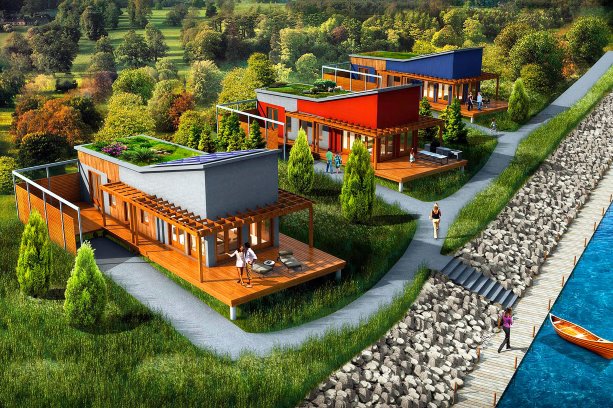At a recent Habitat for Humanity event, a crew of six people erected a demonstration house in just 41 minutes. Not a record by any means, but an acceptable construction schedule for a prefabricated steel building of this size manufactured by GreenTerra Homes.
For Max Broojerd, chief operating officer of GreenTerra, that demonstration isn’t so much about building a single house, but about ushering in a new era of efficiently constructed, affordable and scalable housing, from one-offs to multi-unit townhouse complexes and entire subdivisions.
Broojerd has invested the last three years in ramping up his 700,000 square-foot prefabrication facility in Trenton, Ont. It’s currently Canada’s only CSA-A66-certified steel prefab, modular, mobile home factory.
"The manufacturing technology was originally developed in New Zealand, but we now own the licensing and patents," says Broojerd. "Using this system we can produce homes that are up to 99.9 per cent complete — including wiring and plumbing — deliver them and place them on basement foundations, slabs or post-and-beam platforms."
He notes it’s the proprietary software controlling the machinery that helps make the manufacturing process so efficient.
"Roll formers are roll formers," he says. "But the software directs the machinery to crimp, cut and punch in the most efficient location for each panel size, taking into consideration the profile of the steel studs specific to our product."
Steel coil can be roll-formed into nine-by-10-foot wall panels and then bolted, screwed and riveted by shop-floor crews in a single, orchestrated process. GreenTerra is currently partnering with Loyalist College to train workers as production ramps up to an expected 140-person staff.
Modules and completed homes are loaded on flatbed trailers and delivered to building sites. It’s easiest to deliver loads 10 feet wide, requiring no highway escort, although some loads as wide as 16 feet may be delivered with escorts.
Fully assembled smaller homes of 450 to 650 square feet are CSA-approved so no inspection is required at the site. For larger format buildings, the homes are delivered as shells without insulation panels in the most complete state possible prior to building inspection.
Current costs for GreenTerra’s smallest prefab home is about $16,000 with a five-bedroom home priced at about $180,000. GreenTerra is currently completing orders for 3,000 homes. Some will be delivered to Habitat for Humanity, while other units are being delivered by truck and barge to First Nation projects in Nunavut and the James Bay area.
"The homes are well-insulated with R-30 for walls, R-60s in attics and heavy insulation in floors, so they can be installed on post-and-beam platforms in the north," says Broojerd. "Most of these are delivered in townhouse format, with an outside unit identified as the ‘wet’ module and set up for waste and water service fittings and an electric meter. The rest of the modules are welded together side by side. Many of these homes are being assembled along coastlines and there’s concern about changes in the environment, requiring their houses to be moved. They need housing that’s both portable and indestructible. These steel-framed units would survive even if they rolled over."
Zoning regulations offer the greatest barrier to more affordable home ownership in cities. However, developer clients in Ottawa and Kingston have received zoning approval for subdivisions of up to 100 units, based on GreenTerra’s "micro-home" concept. GreenTerra is also supplying 200 units for a seniors’ complex in Colborne, Ont. Once houses are delivered, GreenTerra estimates the subdivisions can be completed in a matter of days.
Broojerd says he’s frequently asked how quickly a house can be completed, from order to delivery. A six-person crew could prefabricate as many as 40 modular houses in four weeks. A house built to 99.9 per cent completion requires about three weeks. However, he notes it’s a matter of how much money the client wants to spend to ramp up production and have more units delivered on an accelerated schedule.
"We could build you a prefabricated replica of the Great Pyramid of Giza in a day, if you have the money in your budget," he says.











Recent Comments
comments for this post are closed